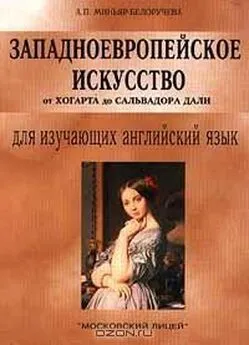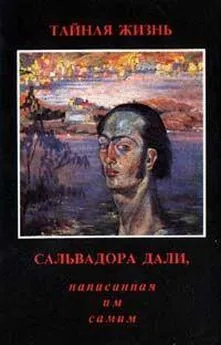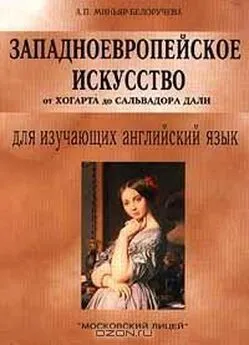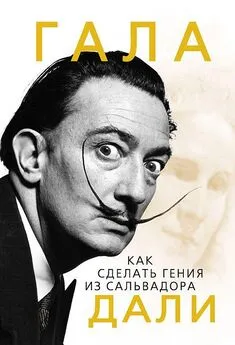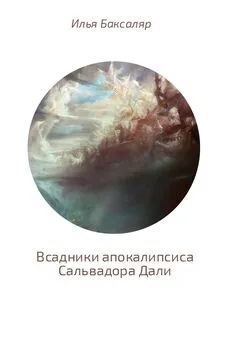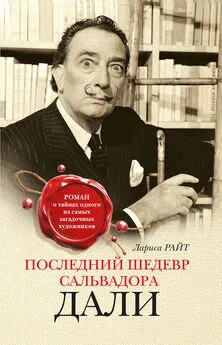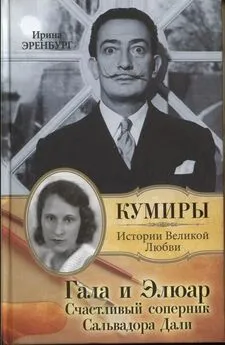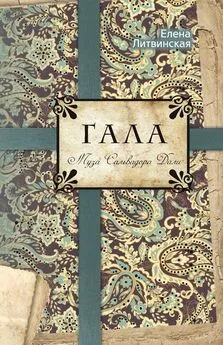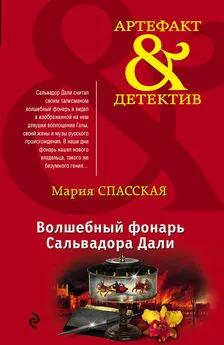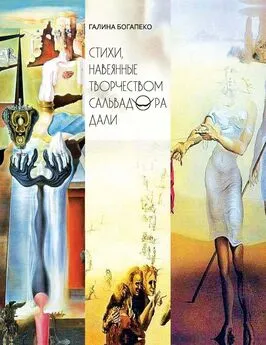Западноевропейское искусство от Хогарта до Сальвадора Дали
- Название:Западноевропейское искусство от Хогарта до Сальвадора Дали
- Автор:
- Жанр:
- Издательство:неизвестно
- Год:неизвестен
- ISBN:нет данных
- Рейтинг:
- Избранное:Добавить в избранное
-
Отзывы:
-
Ваша оценка:
Западноевропейское искусство от Хогарта до Сальвадора Дали краткое содержание
«Московский Лицей»
пособие для изучающих английский язык
издание второе переработанное и дополненное
Москва – 1999
Рецензенты:
Е. Б. Яковлева, доктор филологических наук, профессор
И. В. Шевлягина, кандидат филологических наук, доцент
РЕКОМЕНДОВАНО кафедрой иностранных языков исторического факультета МГУ им. М. В. Ломоносова
Тексты настоящего пособия охватывают почти три века истории западноевропейского искусства от Хогарта до Сальвадора Дали. Это позволяет обучаемым наряду с усвоением обширного лексического материала, приобрести культурологические знания, поскольку тексты содержат информацию о жизни и творчестве крупнейших западно-европейских художников XVIII – XX вв. Система упражнений направлена на усвоение лексического материала и развитие навыков устной речи.
Данная книга является второй частью цикла учебных пособий «Западноевропейское искусство (для изучающих английский язык)». В первую книгу вошли тексты, охватывающие пять веков западноевропейской живописи oт Джотто до Рембрандта. Данное пособие предназначено для студентов-искусствоведов, учащихся классических гимназий, лицеистов и всех изучающих английский язык и интересующихся западноевропейским искусством.
© Миньяр-Белоручева А. П.
© Оформление «Московский Лицей». 1999
ISBN 5-7611-0182-3
___DdeLink__6_1602129716 Издательство Адрес: Телефон
акс
Тираж 5000 экз.
Западноевропейское искусство от Хогарта до Сальвадора Дали - читать онлайн бесплатно полную версию (весь текст целиком)
Интервал:
Закладка:
Make sure you know how to pronounce the following words:
Toulouse-Lautrec; Degas; Picasso; adolescence; alienated; balustrade; cabaret; cafe; dwarf; profile; psychological
At the Moulin Rouge – «Мулен Руж»
I. Read the text. Make sure you understand it. Mark the following statements true or false.
1. Toulouse-Lautrec's parents were French aristocrats.
2. Toulouse-Lautrec took refuge in the wilderness.
3. Toulouse-Lautrec depicted poplars and cathedrals.
4. At the Moulin Rouge was influenced by Renoir.
5. Degas admired Toulouse-Lautrec's works of art.
6. Toulouse-Lautrec's line resembled that of Cezanne's.
II. How well have you read? Can you answer the following questions?
1. Why was Toulouse-Lautrec alienated from his family's fashionable life?
2. What did Toulouse-Lautrec like to depict? Why?
3. Who was Toulouse-Lautrec's idol?
4. What is represented in Toulouse-Lautrec's At the Moulin Rouge ? How did the painter depict himself and his cousin in this picture?
5. What did Toulouse-Lautrec do to reinforce the psychological impact of this picture? What did Toulouse-Lautrec do to impress the observer?
6. What was the dominant influence in Paris in 1900? Who was influenced by Toulouse-Lautrec's works of art?
III. i. Give Russian equivalents of the following phrases:
for the rest of one's existence; to take refuge in; uncritical acceptance; to be influenced by; tolerant humanity; it is significant that; the psychological impact; at the bottom of the picture; surprising colour contrasts; the dominant influence; to extend the picture on all four sides; the plunging perspective; to light from below; drawing style; at the right.
ii. Give English equivalents of the following phrases:
неожиданные цветовые контрасты; раздвинуть картину с четырех сторон; терпимость; осветить снизу; психологическое влияние; глубинная перспектива; знаменательно то, что; основное влияние; в течение оставшейся жизни; найти убежище в; стиль рисунка; быть под влиянием.
iii. Make up questions of your own with the given phrases.
iv. Arrange the/allowing in the pairs of synonyms:
a) noble; existence; alienated; humanity; deformity; idol; tolerant;
b) ugliness; aristocratic; life; favourite; patient; hostile; kindness.
IV. Translate the text into English.
Анри Тулуз-Лотрека историки искусства называют постимпрессионистом. Он работал в основном в графике и оставил острые, доходящие до гротеска образы. Это в основном литографии, посвященные типажам парижской богемы. Тулуз-Лотрек делал плакаты с изображением знаменитых танцовщиц и певиц кабаре. В «Мулен де ла Галетт» и «Мулен Руж» художник экспрессивно и драматически изобразил веселье Парижа.
Многочисленные рисунки, эстампы, литографии свидетельствуют о Тулуз-Лотреке как о выдающемся рисовальщике XIX века.
V. Summarize the text.
VI. Topics for discussion.
1. Toulouse-Lautrec's style and characters.
2. Toulouse-Lautrec as a great draughtsman.
Unit XV Gauguin (1848-1903)
Paul Gauguin, a French painter, sculptor and printmaker, was a founder of modern art. A successful businessman without any artistic training Gauguin began painting as an amateur while working as a stockbroker. He soon met Pissarro and Cezanne, as well as the Impressionists. Gauguin absorbed their ideas and techniques and from 1879 to the last Impressionist exhibition in 1886 showed regularly with this group.
Paul Gauguin lived a life that reads like a classic tale of the misunderstood, and uncompromising artist, searching for verities against all odds. He was born in Paris and four years of his childhood lived in Peru (he was partly of Indian origin); six years of his youth he spent as a sailor and was incurably drawn to the exotic and the faraway.
For Gauguin painting itself became identified with his wanderlust and drew him away from all his daily associations. In 1883 he gave up his business career and his bourgeois existence to devote his life to art. Gauguin was convinced that European urban civilisation was incurably ill. His life was nomadic; he moved back and fourth between villages in Brittany and the island of Martinique. Impoverished, deadly ill, and in trouble with the law, Gauguin died on the Marquesas Islands.
Gauguin's departure from Western artistic tradition was prompted by the rebellious attitude that impelled his break from middle-class life. But Gauguin, too, was not an Impressionist at heart. He sought art using ideas rather than the tangible world as a starting point. In this he was influenced by the artist Emil Bernard and by the Symbolist poets Rimbault and Baudelaire. Joining him in renouncing naturalism were the Symbolists, and van Gogh.
Gauguin renounced the formlessness of Impressionist vision and recommended a return to the «primitive» styles as the only refuge for art. What he sought was immediacy of experience. Gauguin did this in his brilliant Vision After the Sermon or, alternatively, Jacob Wrestling with the Angel , painted in 1888, during his second stay in Brittany. This painting marked Gauguin break with Impressionism to follow his own style. He rejected realism in favour of the imagination, and through his expressionist means he made one of the most influential impacts on Western art. In the background Jacob is depicted wrestling with the angel. This event forms the lesson in the Breton rite for the eighth Sunday aflei Trinity. On the preceding day the blessing of horned beasts took place, followed by wrestling contests and a procession with red banners, and at night fireworks, a bonfire that turned the fields red with its glow, and an angel descending from the church tower. In the foreground Gauguin has shown at the right the head of a priest and next to it praying women in Breton costumes. Although the figures are outlined with the clarity that Gauguin derived from his study of Oriental, medieval, and primitive arts, the contrast between the large foreground heads and the smaller groups in the distance still presupposes Western perspective, and is drawn from theatre subjects developed by Duamier, Degas, and Renoir.
In Oceania Gauguin was influenced only to a limited degree by the art of the natives with whom he lived. He took his flattened style with its emphasis on brilliant colour to the South Seas with him, and fitted into it the people whose folkways and personalities attracted him. The attitudes in which he drew and painted them still derive from Impressionist vision. In The Day of the God, of 1894, a happy nude woman and her two children rest at the water's edge below the towering image of the god in the background. But while the poses are free in the Western tradition, the contours have been restored, as continuous and unbroken as in Egyptian or Archaic Greek Art.
Before his death Gauguin said, «I wanted to establish the right to dare everything… The public owes me nothing, since my pictorial oeuvre is but relatively good; but the painters who today profit from this liberty owe me something.» So indeed they did, especially Matisse, but no more than Cubism and abstract movements owe to the pioneer researches of Cezanne.
Make sure you know how to pronounce the fo llowing words:
Paul Gauguin; Duamier; Degas; Breton; Brittany; Oceania; van Gogh; Egypt; Archaic; Marquesas; Tahiti; Peru; Jacob; Martinique; bourgeois; Rimbault.
Vision After the Sermon – «Видение после проповеди»
The Day of the God – «День Бога»
I. Read the text. Make sure you understand it. Mark the following statements true or false.
1. Paul Gauguin began painting as a professional.
2. In 1880 Gauguin devoted his life to business career.
3. Gauguin was convinced that European urban civilisation was incurably ill.
4. Gauguin painted the Vision After the Sermon in 1879.
5. The poses in Gauguin's paintings are as continuous and unbroken as in Egyptian or Archaic Greek Art.
6. Gauguin recommended a return to the Old Masters.
II. How well have you read? Can you answer the following questions?
1. What did Paul Gauguin do early in life? How old was Gauguin when he began painting? What style did Gauguin absorb? Where did he exhibit his works from 1879 to 1886?
2. Why was Gauguin's life nomadic?
3. What did Gauguin renounce and what did he recommend? What did Gauguin seek? What is depicted in the Vision After the Sermon ? How did Gauguin outline the figures? What is the subject of this painting? What did Gauguin depict in the background? What did Gauguin show in the foreground at the right? What did it presuppose?
4. What did Gauguin take to the South Seas with him?
5. What is represented in The Day of the God ?
6. What did Gauguin say before his death?
III. i. Give Russian equivalents of the following phrases:
to begin painting as a amateur; to identify painting with; bourgeois existence; European urban civilisation; nomadic life; the departure from Western artistic tradition; the rebellious attitude to; to break from middle-class life; to renounce the formlessness of Impressionist vision; to presuppose Western perspective; the art of the natives; flattened style; to outline figures with clarity; to restore the contours.
ii. Give English equivalents of the following phrases:
ассоциировать живопись с; бегство от европейской городской цивилизации; бунтарское отношение к; воссоздать контуры; четко обозначить фигуры; искусство туземцев; разрыв со средним классом; критиковать отсутствие формы в картинах импрессионистов; буржуазный образ жизни; кочевая жизнь; плоскостной стиль.
iii. Make up sentences of your own with the given phrases.
iv. Arrange the following in the pairs of synonyms:
a) civilisation; amateur; existence; rebellious; emphasis;
b) defiant; accent; non-professional; being; culture.
IV. Here are descriptions of some of Gauguin's works of art. Match them up to the titles given below.
1. In the background Jacob is depicted wrestling with the angel.
2. A happy nude woman and her two children rest at the water's edge.
a. The Day of the God
b. Vision After the Sermon
V. Translate the text into English.
В истории искусства имя Поля Гогена связывают с символизмом, получившим в конце XIX – начале XX вв. название примитивизм. Несмотря на то, что Гоген стал систематически заниматься живописью довольно поздно, ему удалось выработать собственную манеру письма. Разочарованный в европейской цивилизации, Гоген бежал в экзотические страны. Природа и жизнь туземных племен стали источником его творческого вдохновения. Гоген сознательно пришел к примитивизации формы, стремясь приблизиться к художественным традициям туземного искусства. В общении с первобытной природой Гоген хотел обрести иллюзорный покой. Создав стилизацию таитянского искусства, Гоген вызвал интерес к искусству неевропейских народов.
Читать дальшеИнтервал:
Закладка:
